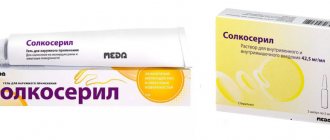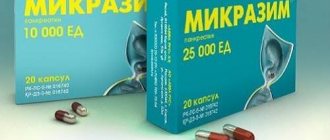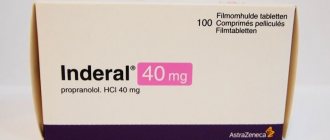Analogues of the drug according to ATC codes:
DEBLOK IBUPROFEN-CHEMOPHARM IBUFEN NUROFEN NUROFEN FOR CHILDREN NUROFEN FOR CHILDREN NUROFEN ULTRACAP NUROFEN FORTE FASPIK FASPIK All
Before using MIG 400 you should consult your doctor. These instructions for use are for informational purposes only. For more complete information, please refer to the manufacturer's instructions.
Diamond MIG-2 (Tablets)
The product is a white round tablet that dissolves well in water. As an active ingredient, the product contains the sodium salt of dichloroisocyanuric acid. Working solutions of the product are transparent.
According to the parameters of acute toxicity, the product belongs to class 3 of moderately hazardous substances when administered into the stomach and to class 4 of slightly hazardous substances when applied to the skin.
Appearance:
white tablets with a slight odor of chlorine, weighing 0.94 - 0.12 g.
Compound:
sodium salt of dichloroisocyanuric acid (80%), mass fraction of active chlorine in the tablet - 48.0 - 4.0% (one tablet of the product contains 0.45 - 0.05 g of active chlorine).
Antimicrobial activity:
against gram-negative and gram-positive microorganisms (except mycobacteria), including bacteria of the E. coli group, staphylococci, streptococci, salmonella.
Application area:
the product is intended for preventive disinfection of any types of equipment, inventory, containers and surfaces of industrial premises made from all types of materials (chlorine-resistant), approved for use in the meat, dairy, baking and beverage industries.
Transportation:
by any means of transport in the original packaging of the manufacturer in accordance with the rules for the transportation of goods (according to GOST 19433-81), valid for each type of transport and guaranteeing the safety of the product and container.
Storage:
when packaged, store in a closed container from the manufacturer, in places protected from moisture and direct sunlight, away from sources of heat and open fire, in a ventilated area, separately from food products.
Environmental protection measures:
do not allow the product and rinsing water to enter wastewater, surface water, groundwater and soil without dilution.
Package:
plastic jars with a capacity of 1 kg.
Best before date:
3 years.
Methods of application, precautionary measures and first aid are described in detail in the Instructions for use at food industry enterprises: meat industry No. 13/06, bakery and confectionery No. 16/07, dairy No. 17/07 and beverage production No. 18/07.
Certificate of state registration No. 77.99.36.2.U.4573.6.07 dated June 26, 2007
Certificate of Conformity No. ROSS.RU.AYA46.V54560.
| No. | Food industry | Active chlorine content in working solutions, % | Number of tablets for preparation: 100 l. working solution, pcs. | Cost 1 l. working solution, rub. | Cost of processing 1 sq.m., in rub. |
| 1 | Meat | 0,015 – 0,030 | 34 – 67 | 0.14 – 0.26 | 0.02-0.04 |
| 2 | Dairy | 0,010 – 0,015 | 23 – 34 | 0.09 – 0.13 | 0.01-0.02 |
| 3 | Bakery | 0,020; 3,0 | 40; 6000 | 0.16; 2.94 | 0.02-3.99 |
| 4 | Beer and drinks | 0.08; 0.25 (disputes) | 179; 556 | 0.71; 2,.21 | 0.12-0.37 |
| 5 | Confectionery | 0.02 | 40 | 0.16 | 0.02 |
| 6 | Fish | 0.05 | 112 | 0.45 | 0.07 |
Release form, composition and packaging
White or almost white, oval, film-coated tablets with a double-sided score and an “E” and “E” embossed on both sides of the score on one side.
| 1 tab. | |
| ibuprofen | 400 mg |
Excipients: corn starch, sodium carboxymethyl starch type A, highly dispersed silicon dioxide, magnesium stearate.
Shell composition: hypromellose, titanium dioxide (E171), povidone K30, macrogol 4000.
10 pieces. - blisters (1) - cardboard packs. 10 pcs. - blisters (2) - cardboard packs.
pharmachologic effect
Non-steroidal anti-inflammatory drug (NSAID). Ibuprofen is a derivative of propionic acid and has analgesic, antipyretic and anti-inflammatory effects due to the non-selective blockade of COX-1 and COX-2, as well as an inhibitory effect on the synthesis of prostaglandins.
The analgesic effect is most pronounced for inflammatory pain. The analgesic activity of the drug is not of the narcotic type.
Like other NSAIDs, ibuprofen has antiplatelet activity.
Pharmacokinetics
Suction
After oral administration, the drug is well absorbed from the gastrointestinal tract. Cmax of ibuprofen in plasma is approximately 30 mcg/ml and is achieved approximately 2 hours after taking the drug at a dose of 400 mg.
Distribution
Plasma protein binding is about 99%. It is slowly distributed in and cleared from synovial fluid more slowly than from plasma.
Metabolism
Ibuprofen is metabolized in the liver primarily by hydroxylation and carboxylation of the isobutyl group. Metabolites are pharmacologically inactive.
Removal
It is characterized by two-phase elimination kinetics. T1/2 from plasma is 2-3 hours. Up to 90% of the dose can be found in the urine in the form of metabolites and their conjugates. Less than 1% is excreted unchanged in urine and, to a lesser extent, in bile.
Dosage
The optimal dosage is determined individually after diagnosis, an accurate diagnosis, and determination of the patient’s health status. In this case, the nosological form of the disease, as well as the degree of manifestation of the existing symptoms, should be taken into account.
- For adults, two hundred to eight hundred mg per day is recommended. Frequency of administration – 3 – 4 times.
- For children, you can use from twenty to forty mg per kilogram per day several times.
It should be noted that MIG 400 can be used not only for oral administration, but also for external use. The optimal course of treatment is from two to three weeks, since the exact period is determined by the characteristics of the person’s condition.
MIG 400: DOSAGE
The drug is taken orally. The dosage regimen is set individually depending on the indications.
For adults and children over 12 years of age, the drug is prescribed, as a rule, at an initial dose of 200 mg 3-4 times a day. To achieve a rapid therapeutic effect, the dose can be increased to 400 mg 3 times a day. Once the therapeutic effect is achieved, the daily dose is reduced to 600-800 mg.
The drug should not be taken for more than 7 days or in higher doses. If it is necessary to use it for a longer period or in higher doses, consult a doctor.
In patients with impaired renal, liver or cardiac function, the dose of the drug should be reduced.
Instructions for use
Mig 400 is intended for oral administration. The dosage is determined according to indications. As a rule, children over 12 years of age and adults Mig 400 are prescribed 3-4 times a day, 200 mg (initial dosage). In order to enhance the therapeutic effect, the dose is increased (3 times a day, 400 mg).
After the therapeutic effect is achieved, the dosage is reduced to 600-800 mg per day. Mig 400 tablets are not recommended to be taken for more than a week or in dosages higher than recommended. For persons with problems with the liver, heart, or kidneys, the dosage is reduced.
Overdose
Symptoms: abdominal pain, nausea, vomiting, lethargy, drowsiness, depression, headache, tinnitus, metabolic acidosis, coma, acute renal failure, decreased blood pressure, bradycardia, tachycardia, atrial fibrillation, respiratory arrest.
Treatment: gastric lavage (only within an hour after administration), activated charcoal, alkaline drinking, forced diuresis, symptomatic therapy (correction of the acid-base state, blood pressure).
Oral tablets MIG 400 (MIG 400)
Instructions for medical use of the drug
Description of pharmacological action
Inhibits cyclooxygenase and blocks PG biosynthesis.
Indications for use
Pain syndrome (headache, including migraine, joint pain of rheumatic origin, myalgia, toothache, dysalgomenorrhea, neuralgia, sciatica), colds, flu (pain, chills, fever); other conditions accompanied by pain.
Release form
film-coated tablets 400 mg; contour cell packaging 10, cardboard pack 1; film-coated tablets 400 mg; contour cell packaging 10, cardboard pack 2; film-coated tablets 400 mg; contour cell packaging 10, cardboard pack 1; film-coated tablets 400 mg; contour cell packaging 10, cardboard pack 2;
Pharmacodynamics
The analgesic effect is due to a decrease in the intensity of inflammation and a weakening of the algogenicity of bradykinin; anti-inflammatory - by interfering in different parts of the pathogenesis of inflammation (increased permeability and microcirculation processes are normalized, the liberation of histamine, bradykinin and other inflammatory mediators is reduced, the formation of ATP is inhibited, which means the energy of the inflammatory process is reduced, etc.); antipyretic - by reducing the excitability of the heat-regulating centers of the diencephalon.
Pharmacokinetics
Absorption After oral administration, the drug is well absorbed from the gastrointestinal tract. Cmax of ibuprofen in plasma is approximately 30 mcg/ml and is achieved approximately 2 hours after taking the drug at a dose of 400 mg. Distribution Plasma protein binding is about 99%. It is slowly distributed in and cleared from synovial fluid more slowly than from plasma. Metabolism Ibuprofen is metabolized in the liver mainly by hydroxylation and carboxylation of the isobutyl group. Metabolites are pharmacologically inactive. Excretion Characterized by two-phase excretion kinetics. T1/2 from plasma is 2-3 hours. Up to 90% of the dose can be found in the urine in the form of metabolites and their conjugates. Less than 1% is excreted unchanged in urine and, to a lesser extent, in bile.
Use during pregnancy
During pregnancy (especially in the last trimester) and lactation, use with caution and only after consulting a doctor.
Contraindications for use
Absolute: hypersensitivity (including to aspirin and other NSAIDs); peptic ulcer of the stomach and duodenum; bronchial asthma caused by aspirin. Relative: liver and kidney diseases, chronic heart failure.
Side effects
Dizziness, agitation, sleep disturbances, dyspeptic disorders (stomach pain, nausea), exacerbation of bronchial asthma, skin rash.
Directions for use and doses
Orally, after eating, without chewing, with plenty of water. Adults and children over 12 years old - 2 tablets at the initial dose, then (if necessary) - 1-2 tablets. every 4–6 hours; maximum daily dose - 6 tablets.
Overdose
Symptoms: abdominal pain, nausea, vomiting, lethargy, drowsiness, depression, headache, tinnitus, metabolic acidosis, coma, acute renal failure, decreased blood pressure, bradycardia, tachycardia, atrial fibrillation, respiratory arrest. Treatment: gastric lavage (only within an hour after administration), activated charcoal, alkaline drinking, forced diuresis, symptomatic therapy (correction of the acid-base state, blood pressure).
Interactions with other drugs
Reduces the effect of vasodilators, diuretics, enhances the effect of indirect anticoagulants.
Precautions for use
Prescribed with caution for liver and kidney diseases, chronic heart failure. Against the background of other medications (especially antihypertensives, including diuretics, cardiac, anticoagulants), for diseases of the cardiovascular system and bronchial asthma; elderly people and children under 12 years of age can only be used after consulting a doctor.
Storage conditions
List B.: In a place protected from light, at a temperature not exceeding 30 °C.
Best before date
36 months
ATX classification:
M Musculoskeletal system
M01 Anti-inflammatory and antirheumatic drugs
M01A Non-steroidal anti-inflammatory drugs
M01AE Propionic acid derivatives
M01AE01 Ibuprofen
Drug interactions
The effectiveness of furosemide and thiazide diuretics may be reduced due to sodium retention associated with inhibition of prostaglandin synthesis in the kidneys.
Ibuprofen may enhance the effect of oral anticoagulants (simultaneous use is not recommended).
When administered simultaneously with acetylsalicylic acid, ibuprofen reduces its antiplatelet effect (an increase in the incidence of acute coronary insufficiency in patients receiving small doses of acetylsalicylic acid as an antiplatelet agent is possible).
Ibuprofen may reduce the effectiveness of antihypertensive medications.
Isolated cases of increased plasma concentrations of digoxin, phenytoin and lithium while taking ibuprofen have been described in the literature.
Ibuprofen, like other NSAIDs, should be used with caution in combination with acetylsalicylic acid or other NSAIDs and corticosteroids, because this increases the risk of adverse effects of the drug on the gastrointestinal tract.
Ibuprofen may increase plasma concentrations of methotrexate.
Combination therapy with zidovudine and ibuprofen may increase the risk of hemarthrosis and hematoma in HIV-infected patients with hemophilia.
The combined use of ibuprofen and tacrolimus may increase the risk of nephrotoxicity due to impaired prostaglandin synthesis in the kidneys.
Ibuprofen enhances the hypoglycemic effect of oral hypoglycemic agents and insulin; Dose adjustment may be necessary.
MIG 400: SIDE EFFECTS
From the digestive system: NSAID gastropathy - abdominal pain, nausea, vomiting, heartburn, loss of appetite, diarrhea, flatulence, constipation; rarely - ulceration of the gastrointestinal mucosa, which in some cases is complicated by perforation and bleeding; Possible irritation or dryness of the oral mucosa, pain in the mouth, ulceration of the gum mucosa, aphthous stomatitis, pancreatitis, hepatitis.
From the respiratory system: shortness of breath, bronchospasm.
From the senses: hearing loss, ringing or noise in the ears, toxic damage to the optic nerve, blurred vision or double vision, scotoma, dryness and irritation of the eyes, swelling of the conjunctiva and eyelids (allergic origin).
From the central nervous system and peripheral nervous system: headache, dizziness, insomnia, anxiety, nervousness and irritability, psychomotor agitation, drowsiness, depression, confusion, hallucinations, rarely - aseptic meningitis (more often in patients with autoimmune diseases).
From the cardiovascular system: heart failure, tachycardia, increased blood pressure.
From the urinary system: acute renal failure, allergic nephritis, nephrotic syndrome (edema), polyuria, cystitis.
Allergic reactions: skin rash (usually erythematous or urticarial), skin itching, angioedema, anaphylactoid reactions, anaphylactic shock, bronchospasm or dyspnea, fever, erythema multiforme exudative (including Stevens-Johnson syndrome), toxic epidermal necrolysis (syndrome) Lyell), eosinophilia, allergic rhinitis.
From the hematopoietic system: anemia (including hemolytic, aplastic), thrombocytopenia and thrombocytopenic purpura, agranulocytosis, leukopenia.
From laboratory parameters: possible increase in bleeding time, decrease in serum glucose concentration, decrease in creatinine clearance, decrease in hematocrit or hemoglobin, increase in serum creatinine concentration, increase in the activity of liver transaminases.
With long-term use of the drug in high doses, the risk of developing ulcerations of the gastrointestinal mucosa, bleeding (gastrointestinal, gingival, uterine, hemorrhoidal), and visual impairment (impaired color vision, scotoma, damage to the optic nerve) increases.
What does Mig 400 help with?
Mig 400 is a drug with a strong analgesic effect. It can be found in any pharmacy and taken for toothache, headaches and other types of pain.
Description and operation of Mig 400
Mig 400 tablets are classified as NSAIDs (non-steroidal anti-inflammatory drugs), the active ingredient is ibuprofen. The pills are oval in shape, have a double-sided score for separation and original embossing on both sides. The tablets are coated, so they are less irritating to the stomach.
In addition to 400 g of ibuprofen, the medicine also includes excipients:
- sodium carboxymethyl starch;
- starch;
- silica;
- macrogol;
- povidone.
Mig 400 acts similarly to other non-steroidal anti-inflammatory drugs. The main effect is analgesic. As a derivative of propionic acid, ibuprofen has an anti-inflammatory effect and reduces fever and normalizes temperature. The drug helps stabilize the condition by indiscriminately blocking cyclooxygenase types 1 and 2.
Ibuprofen also inhibits the release of prostaglandins, mediators of inflammation.
The effect of the drug is not associated with narcotic influence, it does not have as many side effects as narcotic analgesics do. When carrying out treatment, it is necessary to take into account the antiplatelet activity of ibuprofen - it thins the blood, preventing platelets from sticking together.
Indications for use and contraindications
Mig 400 helps best with pain associated with inflammatory diseases. Therefore, NSAIDs are more often prescribed for pathologies of the musculoskeletal system caused by inflammation:
Diclovit is effective in gynecology and urology for the treatment of infectious and inflammatory diseases. Read more >>
- bursitis;
- synovitis;
- rheumatoid arthritis;
- psoriatic arthritis;
- gout
The drug can be taken for osteochondrosis in the acute stage - it reduces pain. Also among the list of indications is degenerative joint disease - arthrosis, which causes stiffness and pain.
Mig 400 quickly relieves migraines and headaches of vascular origin.
The medicine helps reduce pain due to caries, pulpitis and other dental pathologies.
Mig 400 also helps with trigeminal neuralgia, neuritis and neuralgia of other localizations. According to the annotation, the medicine is used for muscle pain (myalgia). In women, the drug will quickly reduce pain during menstruation.
The drug can also be taken as an antipyretic for acute respiratory viral infections, influenza, and sore throat.
The list of contraindications includes pregnancy, age under 12 years, and breastfeeding. The drug is also contraindicated in the following conditions and diseases:
- erosions, gastrointestinal ulcers;
- acute gastritis;
- Crohn's disease;
- hemophilia and other blood diseases associated with decreased clotting;
- any bleeding other than menstrual bleeding;
- pathology of the optic nerve.
The drug should not be taken if you have hypersensitivity, allergies, or the development of the “aspirin triad”. Take tablets with great caution if you have previously experienced allergic reactions to other NSAIDs. Under the supervision of a doctor and a short course, treatment is possible for kidney and liver damage, in old age, for hypertension, and heart failure.
Side effects
Usually, one-time use of the medicine does not cause any problems. But with course therapy, a number of side effects are possible. Most often they are associated with gastrointestinal problems and include:
- gastropathy;
- pain in the abdomen;
- poor appetite;
- constipation or diarrhea;
- bloating;
- nausea, vomiting;
- heartburn;
- stomatitis;
- dry mouth;
- hepatitis;
- pancreatitis.
In rare cases, ulcerative and erosive lesions of the gastrointestinal tract occur; in severe cases, they can be complicated by perforation and bleeding. This usually happens when you overdose or take it for too long.
Also, side effects sometimes include bronchospasm, which usually serves as a form of allergy to NSAIDs. Some patients experience noise or ringing in the ears, visual disturbances, and double vision. The nervous system may react with nervousness, mood swings, and drowsiness.
Severe cases may cause confusion; meningitis is not infectious.
Exact instructions Mig 400
The medicine is taken orally, the dosage is selected by a specialist according to the indications. From the age of 12 years and older, the initial dose is ? tablets, or 200 mg, per day, take this dose 3-4 times. A different treatment regimen can be carried out; this is usually required for a faster analgesic effect. Take 400 mg three times a day.
The maximum dose on the first day is 1200 mg, it is immediately reduced to 600 mg when the effect is achieved.
The longest course of treatment, according to the recommendations of the instructions, is 7 days.
In case of overdose, the following signs are observed: depression and drowsiness, acidosis, coma, renal failure, arrhythmias.
Analogues of Mig 400 and other information
The cost of Mig 400 is 80 rubles/10 tablets. Among the analogues there are many drugs from the group of NSAIDs based on ibuprofen, as well as other drugs:
The drug is not compatible with alcohol. Simultaneous use increases the risk of liver damage, irritation of the stomach and intestines, and can provoke various bleedings (intestinal, gastric, pulmonary, nasal).
Mig 400 is capable of masking the symptoms of infectious and inflammatory diseases, so treatment for such pathologies must be done with caution. In people with bronchial asthma, shortness of breath and bronchospasm are the most common side effects of taking NSAIDs.
It is necessary to immediately stop therapy in case of any visual impairment and the appearance of kidney symptoms - damage to these organs is possible. In persons with liver disease, monitoring of liver test parameters is required.
i
Please rate the article, we tried:
Source: https://tyubik.net/tabletki/216-ot-chego-pomogaet-mig-400.html
Contraindications
- erosive and ulcerative diseases of organs: gastrointestinal tract (incl.
- h.
- peptic ulcer of the stomach and duodenum in the acute phase,
- Crohn's disease,
- UC);
- "aspirin triad";
- hemophilia and other bleeding disorders (incl.
- hypocoagulation),
- hemorrhagic diathesis;
- bleeding of various etiologies;
- deficiency of glucose-6-phosphate dehydrogenase;
- optic nerve diseases;
- pregnancy;
- lactation period;
- children under 12 years of age;
- hypersensitivity to the components of the drug;
- history of hypersensitivity to acetylsalicylic acid or other NSAIDs.
The drug should be used with caution in the following cases: old age; heart failure; arterial hypertension; liver cirrhosis with portal hypertension; liver and/or renal failure, nephrotic syndrome, hyperbilirubinemia; peptic ulcer of the stomach and duodenum (history), gastritis, enteritis, colitis; blood diseases of unknown etiology (leukopenia and anemia).
Side effects from taking
Nonsteroidal anti-inflammatory drugs, including Mig tablets, cause negative consequences for the body. Dyspeptic symptoms are common: nausea, bowel problems such as constipation or diarrhea, heartburn, nausea, pain in the upper abdomen.
All this is due to the effect of the drug on the mucous membrane of the stomach and duodenum. With excessive influence on these organs, a person develops gastritis or ulcerative defects, which requires additional treatment.
In addition, according to reviews of Mig tablets, people experience dysfunction of the pancreas (pancreatitis) and liver, as well as temporary changes in the central nervous system.
It is interesting to know how to treat migraine with folk remedies: effective medicinal herbs.
Everything about how to take Analgin without side effects of the drug.
Correct use of Next for headaches.
In addition to the described disorders, it is possible to develop:
- disruption of the bronchopulmonary system with the development of shortness of breath or bronchospasm, which causes respiratory failure;
- changes in the functioning of the heart and blood vessels with the appearance of symptoms of heart failure, acceleration of heart rate; Long-term use of tablets leads to impaired maturation of blood cells.
special instructions
If signs of gastrointestinal bleeding occur, ibuprofen should be discontinued.
Ibuprofen can mask objective and subjective symptoms, so the drug should be prescribed with caution to patients with infectious diseases.
The occurrence of bronchospasm is possible in patients suffering from bronchial asthma or allergic reactions in history or in the present.
Side effects can be reduced when using the drug in the minimum effective dose. With long-term use of analgesics, there is a possible risk of developing analgesic nephropathy.
Patients who experience visual disturbances during ibuprofen therapy should discontinue treatment and undergo an ophthalmological examination.
Ibuprofen may increase liver enzyme activity.
During treatment, monitoring of the peripheral blood picture and the functional state of the liver and kidneys is necessary.
When symptoms of gastropathy appear, careful monitoring is indicated, including esophagogastroduodenoscopy, a blood test to determine hemoglobin, hematocrit, and a stool test for occult blood.
To prevent the development of NSAID gastropathy, it is recommended to combine ibuprofen with prostaglandin E drugs (misoprostol).
If it is necessary to determine 17-ketosteroids, the drug should be discontinued 48 hours before the study.
During the treatment period, ethanol intake is not recommended.
Impact on the ability to drive vehicles and operate machinery
Patients should refrain from all activities that require increased attention and speed of psychomotor reactions.
Directions for use and dosage
The tablets are taken orally.
The doctor sets the dosage regimen for MIG 400 individually, based on the indications.
The initial dose of the drug for children over 12 years of age and adults is usually 200 mg 3-4 times a day. It can be increased by 2 times in cases where it is necessary to achieve a rapid therapeutic effect; in this case, the frequency of administration should not exceed 3 times a day. Once the therapeutic effect is achieved, the dose should be reduced to 600-800 mg per day.
It is not recommended to take MIG 400 for longer than 1 week or at a higher dosage. If it is necessary to use the drug for a longer period or in higher doses, consult a doctor.
The dose of the drug must be reduced if the function of the kidneys, liver or heart is impaired.








